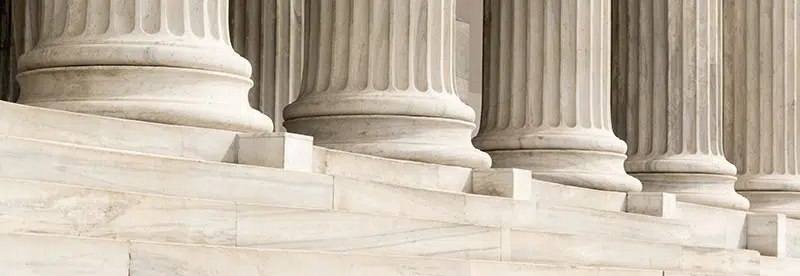On June 21, 2021, the U.S. Supreme Court decided the administrative patent judges (APJs) of the Patent Trial and Appeal Board (PTAB) were not constitutionally appointed, and that the patent owner, Arthrex, Inc., is entitled to a remand for a rehearing by the Director of the United States Patent and Trademark Office (USPTO). United States v. Arthrex, Inc., 593 U.S. _ (June 21, 2021).
Background
The PTAB was created in 2012 by the America Invents Act (AIA) as a successor to the Board of Patent Appeals and Interferences (BPAI). It is an administrative adjudicatory body in the USPTO, within the U.S. Department of Commerce, and includes over 100 administrative law judges.
The AIA effectively instituted various revisions to laws/rules that altered the ability to challenge the validity of a patent after issuance (“grant”) by the USPTO, but before filing suit in a court of law. The AIA included the creation of the PTAB and APJs to make decisions regarding patent viability soon after issue.
As a consequence, any issued patent became eligible to be challenged by third parties on technical (e.g., flaws in obtaining the patent) and substantive (e.g., claims are not novel) fronts within certain time frames after issue. This is in contrast to pre-AIA, where an issued patent was presumed to be valid until challenged by suit outside of the USPTO.
What Might This Decision Mean for Patent Holders and Applicants?
This Supreme Court decision provides no guidance regarding what to do after it has been decided that APJs are not constitutional. In this case as it stands, the decision remanded the case to the Director of the USPTO for rehearing, after the Federal Circuit ruled that APJs are not constitutional, and the Supreme Court agreed with the Federal Circuit.
This arguably gives power back to the USPTO as the agency to decide what viable patent claims are. This decision affects hundreds of cases in the litigation pipeline, both at the APJ level and at the Federal Circuit level. This certainly means there will be delays for many cases. This has different implications for both patent holders and patent challengers.
Here is a short summary of AIA procedures:
Inter Partes Review (IPR). IPRs are trials challenging patents based on prior art patents and printed publications. Any issued U.S. patent, regardless of priority, can be challenged by a third party, but patents issuing on applications filed after March 16, 2013, must go through a nine-month period post grant to allow for any possible post-grant review. Although the majority of IPRs involve co-pending litigation, a challenger need not have been sued on the patent or threatened with suit to file a petition. If sued on a patent, a party has one year to file its petition with the PTAB after being served with a complaint. A party must file a petition before filing a declaratory judgment action challenging the validity of a claim of a patent.
If the PTAB determines that a petition demonstrates a “reasonable likelihood” of prevailing on at least one claim, trial is instituted. The patent owner has an opportunity to respond to the allegations, including optionally amending the patent’s claims. Even though the burden of proof is on the petitioner, PTAB statistics indicate that once trial is instituted, in most cases at least some of the challenged claims will be held unpatentable. A final PTAB decision can only be appealed to the U.S. Court of Appeals for the Federal Circuit.
Post-Grant Review (PGR). PGRs are new trial proceedings that apply only to patents issuing from applications filed on or after March 16, 2013, pursuant to the AIA’s first-inventor-to-file system. A patent can only be challenged in a PGR during the first nine months after it issues. In contrast to an IPR, which is limited to prior art patents and printed publications, a PGR can advance a challenge on any basis of unpatentability.
A PGR may be instituted upon a showing that it is “more likely than not” that at least one challenged claim is unpatentable. As with IPR, the patent owner has an opportunity to respond and may file a motion to amend the patent by substituting new claims. The PTAB will issue a final determination within one year after it institutes trial, and an appeal can only be filed with the Federal Circuit.
Derivations. This new PTAB trial procedure determines whether an inventor who is the first to file an application is the true inventor or had derived the invention from someone who files later. The later-filing applicant must initiate the petition, requesting a derivation proceeding within one year of the first publication of a claim in the first-file application that is the same as the later-filed application’s claim. The petition must be supported by substantial evidence of derivation.
This new proceeding is an adaptation of derivation motions in interference proceedings, but only applies to applications filed under the first-inventor-to-file regime effective March 16, 2013.
The Takeaway: Useful New Procedures for Patent Holders
Perhaps the main takeaway from this Supreme Court case is a reminder that these procedures are in place to be taken advantage of. Whether an entity wishes to challenge the validity of patents that might threaten its own IP or an entity is in the position of defending a challenge under these AIA proceedings, AIA proceedings are an avenue to pursue from either position.


